Principles of Bookkeeping, Cash Accounting, and Accrual Accounting
VerifiedAdded on 2023/01/16
|10
|2313
|60
AI Summary
This document provides a comprehensive overview of the principles of double entry bookkeeping, cash accounting, and accrual accounting. It discusses their advantages and disadvantages. It also covers topics such as the GST Act 1999, taxation and superannuation obligations, financial statements, budgeting process, improving cash inflow, use of electronic spreadsheets, and the chart of accounts. Additionally, it explains the purpose of a profit and loss statement.
Contribute Materials
Your contribution can guide someone’s learning journey. Share your
documents today.

Marketing
Secure Best Marks with AI Grader
Need help grading? Try our AI Grader for instant feedback on your assignments.


Table of Contents
Task 1...............................................................................................................................................1
QUESTION ................................................................................................................................1
REFERENCES ...............................................................................................................................7
Task 1...............................................................................................................................................1
QUESTION ................................................................................................................................1
REFERENCES ...............................................................................................................................7
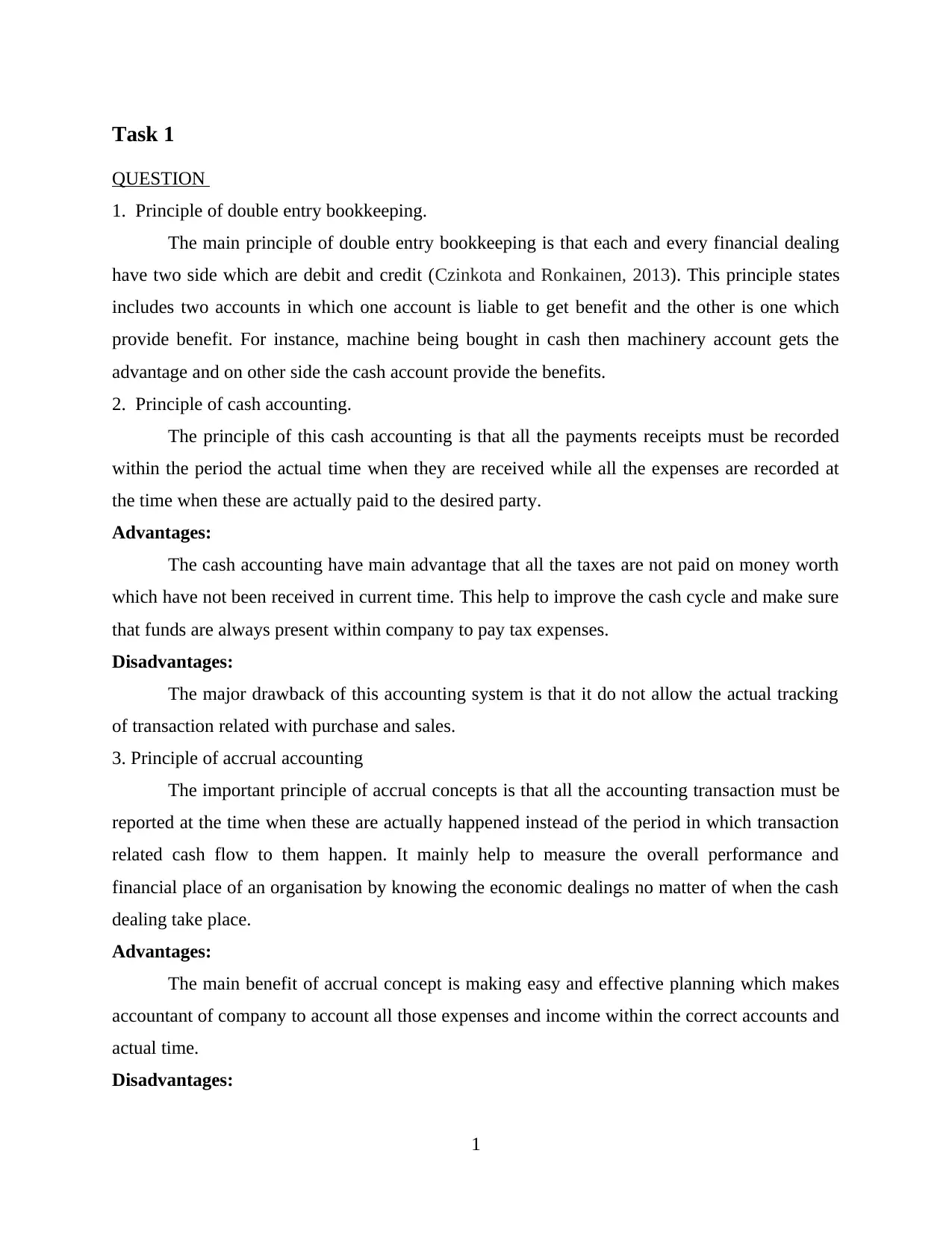
Task 1
QUESTION
1. Principle of double entry bookkeeping.
The main principle of double entry bookkeeping is that each and every financial dealing
have two side which are debit and credit (Czinkota and Ronkainen, 2013). This principle states
includes two accounts in which one account is liable to get benefit and the other is one which
provide benefit. For instance, machine being bought in cash then machinery account gets the
advantage and on other side the cash account provide the benefits.
2. Principle of cash accounting.
The principle of this cash accounting is that all the payments receipts must be recorded
within the period the actual time when they are received while all the expenses are recorded at
the time when these are actually paid to the desired party.
Advantages:
The cash accounting have main advantage that all the taxes are not paid on money worth
which have not been received in current time. This help to improve the cash cycle and make sure
that funds are always present within company to pay tax expenses.
Disadvantages:
The major drawback of this accounting system is that it do not allow the actual tracking
of transaction related with purchase and sales.
3. Principle of accrual accounting
The important principle of accrual concepts is that all the accounting transaction must be
reported at the time when these are actually happened instead of the period in which transaction
related cash flow to them happen. It mainly help to measure the overall performance and
financial place of an organisation by knowing the economic dealings no matter of when the cash
dealing take place.
Advantages:
The main benefit of accrual concept is making easy and effective planning which makes
accountant of company to account all those expenses and income within the correct accounts and
actual time.
Disadvantages:
1
QUESTION
1. Principle of double entry bookkeeping.
The main principle of double entry bookkeeping is that each and every financial dealing
have two side which are debit and credit (Czinkota and Ronkainen, 2013). This principle states
includes two accounts in which one account is liable to get benefit and the other is one which
provide benefit. For instance, machine being bought in cash then machinery account gets the
advantage and on other side the cash account provide the benefits.
2. Principle of cash accounting.
The principle of this cash accounting is that all the payments receipts must be recorded
within the period the actual time when they are received while all the expenses are recorded at
the time when these are actually paid to the desired party.
Advantages:
The cash accounting have main advantage that all the taxes are not paid on money worth
which have not been received in current time. This help to improve the cash cycle and make sure
that funds are always present within company to pay tax expenses.
Disadvantages:
The major drawback of this accounting system is that it do not allow the actual tracking
of transaction related with purchase and sales.
3. Principle of accrual accounting
The important principle of accrual concepts is that all the accounting transaction must be
reported at the time when these are actually happened instead of the period in which transaction
related cash flow to them happen. It mainly help to measure the overall performance and
financial place of an organisation by knowing the economic dealings no matter of when the cash
dealing take place.
Advantages:
The main benefit of accrual concept is making easy and effective planning which makes
accountant of company to account all those expenses and income within the correct accounts and
actual time.
Disadvantages:
1
Secure Best Marks with AI Grader
Need help grading? Try our AI Grader for instant feedback on your assignments.
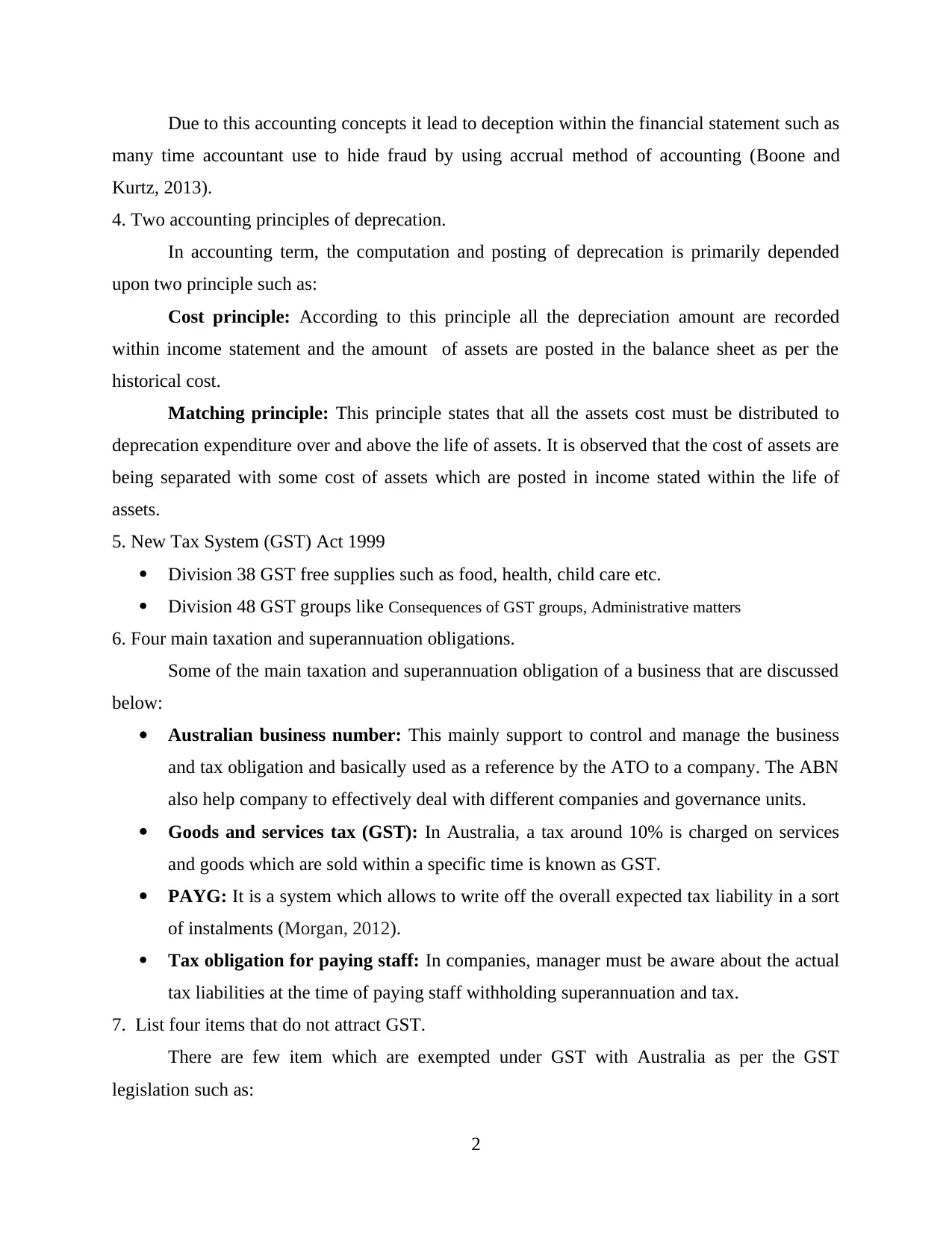
Due to this accounting concepts it lead to deception within the financial statement such as
many time accountant use to hide fraud by using accrual method of accounting (Boone and
Kurtz, 2013).
4. Two accounting principles of deprecation.
In accounting term, the computation and posting of deprecation is primarily depended
upon two principle such as:
Cost principle: According to this principle all the depreciation amount are recorded
within income statement and the amount of assets are posted in the balance sheet as per the
historical cost.
Matching principle: This principle states that all the assets cost must be distributed to
deprecation expenditure over and above the life of assets. It is observed that the cost of assets are
being separated with some cost of assets which are posted in income stated within the life of
assets.
5. New Tax System (GST) Act 1999
Division 38 GST free supplies such as food, health, child care etc.
Division 48 GST groups like Consequences of GST groups, Administrative matters
6. Four main taxation and superannuation obligations.
Some of the main taxation and superannuation obligation of a business that are discussed
below:
Australian business number: This mainly support to control and manage the business
and tax obligation and basically used as a reference by the ATO to a company. The ABN
also help company to effectively deal with different companies and governance units.
Goods and services tax (GST): In Australia, a tax around 10% is charged on services
and goods which are sold within a specific time is known as GST.
PAYG: It is a system which allows to write off the overall expected tax liability in a sort
of instalments (Morgan, 2012).
Tax obligation for paying staff: In companies, manager must be aware about the actual
tax liabilities at the time of paying staff withholding superannuation and tax.
7. List four items that do not attract GST.
There are few item which are exempted under GST with Australia as per the GST
legislation such as:
2
many time accountant use to hide fraud by using accrual method of accounting (Boone and
Kurtz, 2013).
4. Two accounting principles of deprecation.
In accounting term, the computation and posting of deprecation is primarily depended
upon two principle such as:
Cost principle: According to this principle all the depreciation amount are recorded
within income statement and the amount of assets are posted in the balance sheet as per the
historical cost.
Matching principle: This principle states that all the assets cost must be distributed to
deprecation expenditure over and above the life of assets. It is observed that the cost of assets are
being separated with some cost of assets which are posted in income stated within the life of
assets.
5. New Tax System (GST) Act 1999
Division 38 GST free supplies such as food, health, child care etc.
Division 48 GST groups like Consequences of GST groups, Administrative matters
6. Four main taxation and superannuation obligations.
Some of the main taxation and superannuation obligation of a business that are discussed
below:
Australian business number: This mainly support to control and manage the business
and tax obligation and basically used as a reference by the ATO to a company. The ABN
also help company to effectively deal with different companies and governance units.
Goods and services tax (GST): In Australia, a tax around 10% is charged on services
and goods which are sold within a specific time is known as GST.
PAYG: It is a system which allows to write off the overall expected tax liability in a sort
of instalments (Morgan, 2012).
Tax obligation for paying staff: In companies, manager must be aware about the actual
tax liabilities at the time of paying staff withholding superannuation and tax.
7. List four items that do not attract GST.
There are few item which are exempted under GST with Australia as per the GST
legislation such as:
2
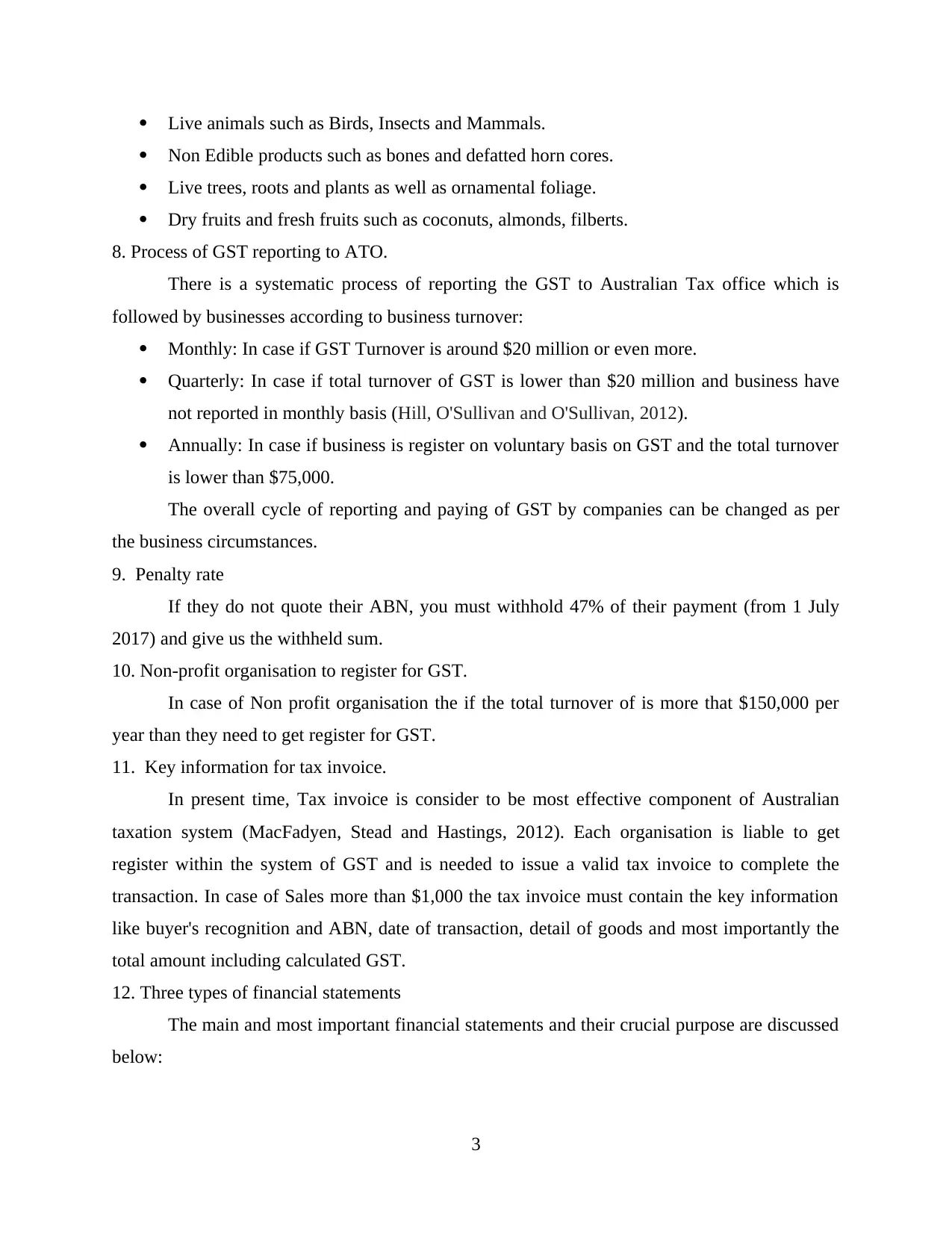
Live animals such as Birds, Insects and Mammals.
Non Edible products such as bones and defatted horn cores.
Live trees, roots and plants as well as ornamental foliage.
Dry fruits and fresh fruits such as coconuts, almonds, filberts.
8. Process of GST reporting to ATO.
There is a systematic process of reporting the GST to Australian Tax office which is
followed by businesses according to business turnover:
Monthly: In case if GST Turnover is around $20 million or even more.
Quarterly: In case if total turnover of GST is lower than $20 million and business have
not reported in monthly basis (Hill, O'Sullivan and O'Sullivan, 2012).
Annually: In case if business is register on voluntary basis on GST and the total turnover
is lower than $75,000.
The overall cycle of reporting and paying of GST by companies can be changed as per
the business circumstances.
9. Penalty rate
If they do not quote their ABN, you must withhold 47% of their payment (from 1 July
2017) and give us the withheld sum.
10. Non-profit organisation to register for GST.
In case of Non profit organisation the if the total turnover of is more that $150,000 per
year than they need to get register for GST.
11. Key information for tax invoice.
In present time, Tax invoice is consider to be most effective component of Australian
taxation system (MacFadyen, Stead and Hastings, 2012). Each organisation is liable to get
register within the system of GST and is needed to issue a valid tax invoice to complete the
transaction. In case of Sales more than $1,000 the tax invoice must contain the key information
like buyer's recognition and ABN, date of transaction, detail of goods and most importantly the
total amount including calculated GST.
12. Three types of financial statements
The main and most important financial statements and their crucial purpose are discussed
below:
3
Non Edible products such as bones and defatted horn cores.
Live trees, roots and plants as well as ornamental foliage.
Dry fruits and fresh fruits such as coconuts, almonds, filberts.
8. Process of GST reporting to ATO.
There is a systematic process of reporting the GST to Australian Tax office which is
followed by businesses according to business turnover:
Monthly: In case if GST Turnover is around $20 million or even more.
Quarterly: In case if total turnover of GST is lower than $20 million and business have
not reported in monthly basis (Hill, O'Sullivan and O'Sullivan, 2012).
Annually: In case if business is register on voluntary basis on GST and the total turnover
is lower than $75,000.
The overall cycle of reporting and paying of GST by companies can be changed as per
the business circumstances.
9. Penalty rate
If they do not quote their ABN, you must withhold 47% of their payment (from 1 July
2017) and give us the withheld sum.
10. Non-profit organisation to register for GST.
In case of Non profit organisation the if the total turnover of is more that $150,000 per
year than they need to get register for GST.
11. Key information for tax invoice.
In present time, Tax invoice is consider to be most effective component of Australian
taxation system (MacFadyen, Stead and Hastings, 2012). Each organisation is liable to get
register within the system of GST and is needed to issue a valid tax invoice to complete the
transaction. In case of Sales more than $1,000 the tax invoice must contain the key information
like buyer's recognition and ABN, date of transaction, detail of goods and most importantly the
total amount including calculated GST.
12. Three types of financial statements
The main and most important financial statements and their crucial purpose are discussed
below:
3
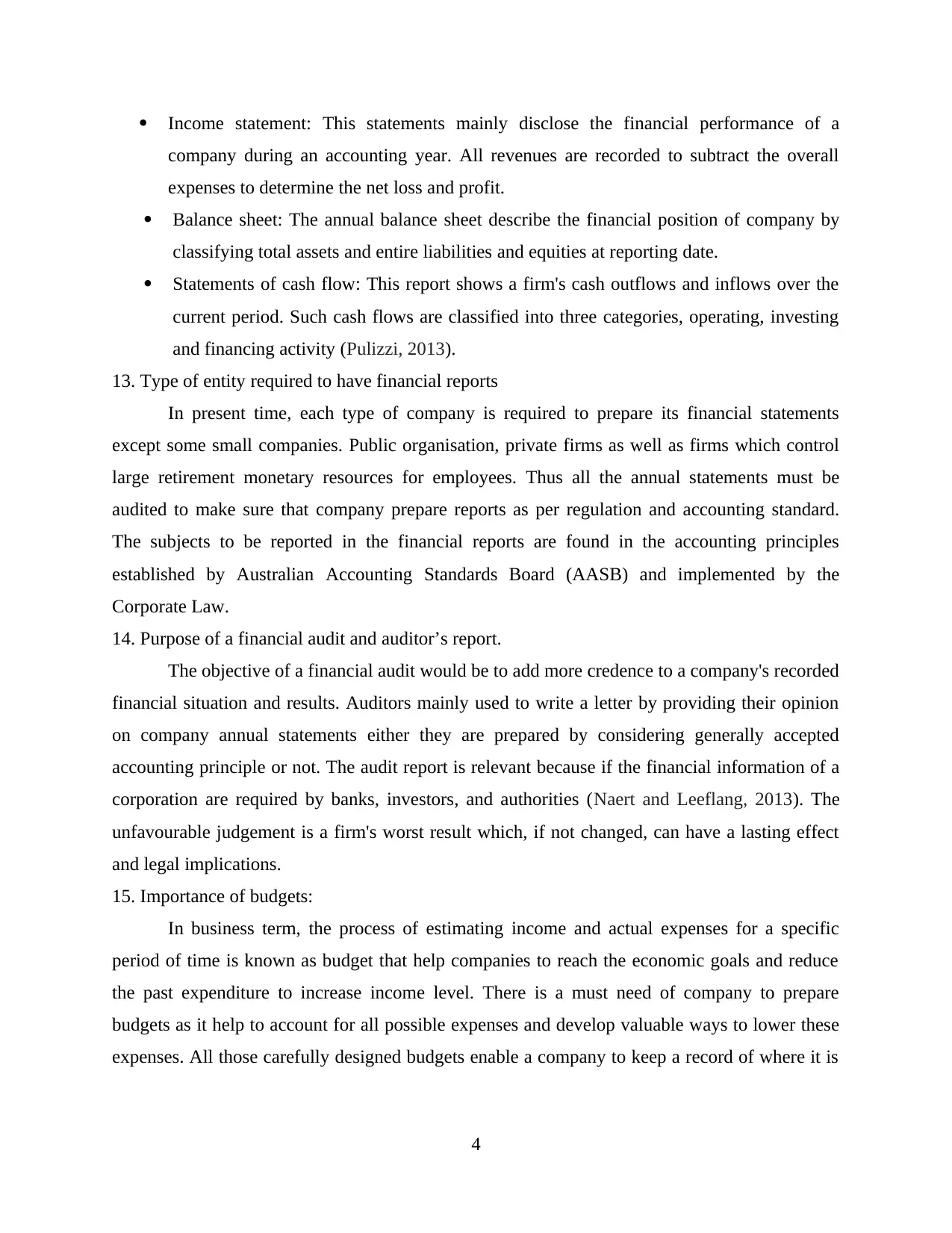
Income statement: This statements mainly disclose the financial performance of a
company during an accounting year. All revenues are recorded to subtract the overall
expenses to determine the net loss and profit.
Balance sheet: The annual balance sheet describe the financial position of company by
classifying total assets and entire liabilities and equities at reporting date.
Statements of cash flow: This report shows a firm's cash outflows and inflows over the
current period. Such cash flows are classified into three categories, operating, investing
and financing activity (Pulizzi, 2013).
13. Type of entity required to have financial reports
In present time, each type of company is required to prepare its financial statements
except some small companies. Public organisation, private firms as well as firms which control
large retirement monetary resources for employees. Thus all the annual statements must be
audited to make sure that company prepare reports as per regulation and accounting standard.
The subjects to be reported in the financial reports are found in the accounting principles
established by Australian Accounting Standards Board (AASB) and implemented by the
Corporate Law.
14. Purpose of a financial audit and auditor’s report.
The objective of a financial audit would be to add more credence to a company's recorded
financial situation and results. Auditors mainly used to write a letter by providing their opinion
on company annual statements either they are prepared by considering generally accepted
accounting principle or not. The audit report is relevant because if the financial information of a
corporation are required by banks, investors, and authorities (Naert and Leeflang, 2013). The
unfavourable judgement is a firm's worst result which, if not changed, can have a lasting effect
and legal implications.
15. Importance of budgets:
In business term, the process of estimating income and actual expenses for a specific
period of time is known as budget that help companies to reach the economic goals and reduce
the past expenditure to increase income level. There is a must need of company to prepare
budgets as it help to account for all possible expenses and develop valuable ways to lower these
expenses. All those carefully designed budgets enable a company to keep a record of where it is
4
company during an accounting year. All revenues are recorded to subtract the overall
expenses to determine the net loss and profit.
Balance sheet: The annual balance sheet describe the financial position of company by
classifying total assets and entire liabilities and equities at reporting date.
Statements of cash flow: This report shows a firm's cash outflows and inflows over the
current period. Such cash flows are classified into three categories, operating, investing
and financing activity (Pulizzi, 2013).
13. Type of entity required to have financial reports
In present time, each type of company is required to prepare its financial statements
except some small companies. Public organisation, private firms as well as firms which control
large retirement monetary resources for employees. Thus all the annual statements must be
audited to make sure that company prepare reports as per regulation and accounting standard.
The subjects to be reported in the financial reports are found in the accounting principles
established by Australian Accounting Standards Board (AASB) and implemented by the
Corporate Law.
14. Purpose of a financial audit and auditor’s report.
The objective of a financial audit would be to add more credence to a company's recorded
financial situation and results. Auditors mainly used to write a letter by providing their opinion
on company annual statements either they are prepared by considering generally accepted
accounting principle or not. The audit report is relevant because if the financial information of a
corporation are required by banks, investors, and authorities (Naert and Leeflang, 2013). The
unfavourable judgement is a firm's worst result which, if not changed, can have a lasting effect
and legal implications.
15. Importance of budgets:
In business term, the process of estimating income and actual expenses for a specific
period of time is known as budget that help companies to reach the economic goals and reduce
the past expenditure to increase income level. There is a must need of company to prepare
budgets as it help to account for all possible expenses and develop valuable ways to lower these
expenses. All those carefully designed budgets enable a company to keep a record of where it is
4
Paraphrase This Document
Need a fresh take? Get an instant paraphrase of this document with our AI Paraphraser
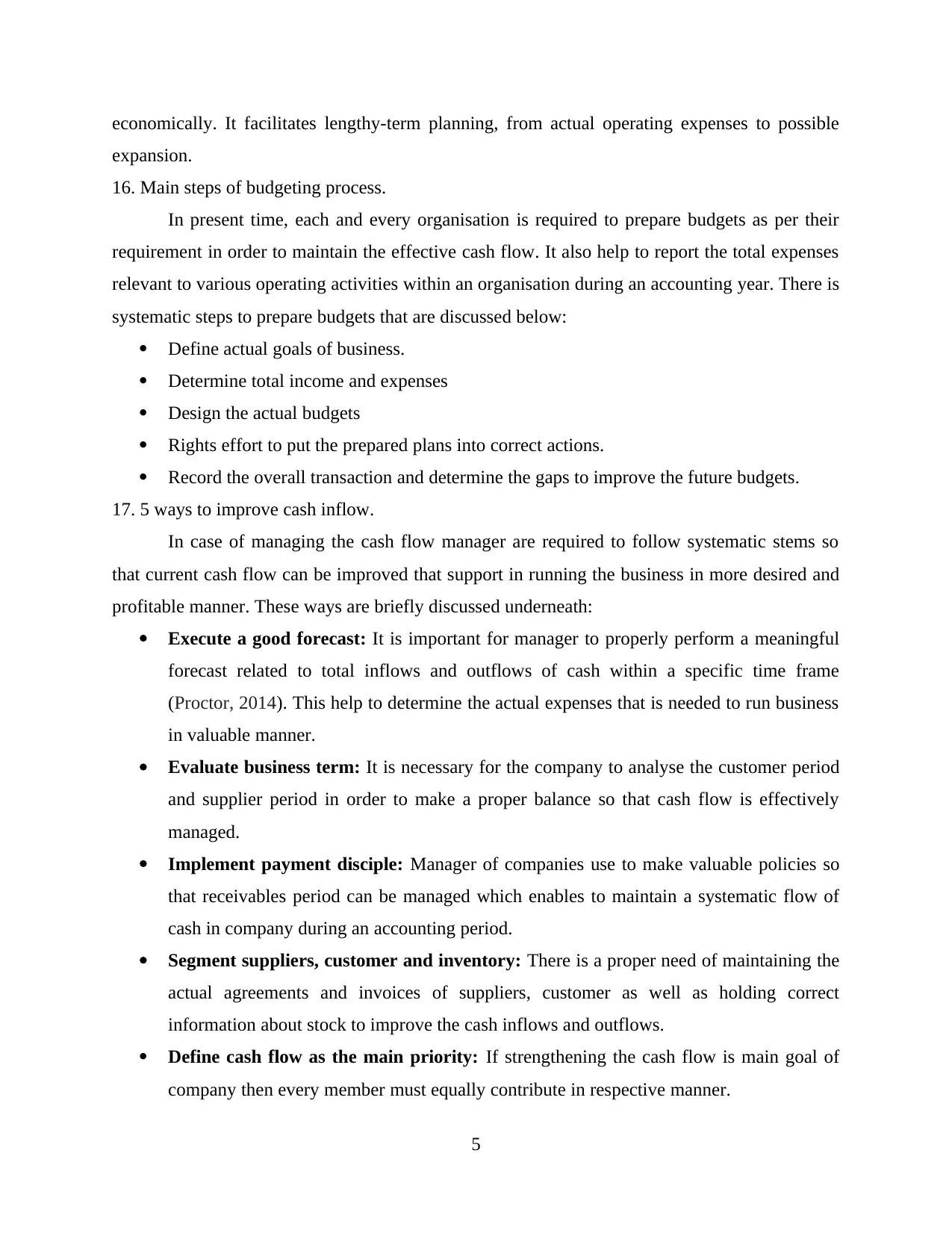
economically. It facilitates lengthy-term planning, from actual operating expenses to possible
expansion.
16. Main steps of budgeting process.
In present time, each and every organisation is required to prepare budgets as per their
requirement in order to maintain the effective cash flow. It also help to report the total expenses
relevant to various operating activities within an organisation during an accounting year. There is
systematic steps to prepare budgets that are discussed below:
Define actual goals of business.
Determine total income and expenses
Design the actual budgets
Rights effort to put the prepared plans into correct actions.
Record the overall transaction and determine the gaps to improve the future budgets.
17. 5 ways to improve cash inflow.
In case of managing the cash flow manager are required to follow systematic stems so
that current cash flow can be improved that support in running the business in more desired and
profitable manner. These ways are briefly discussed underneath:
Execute a good forecast: It is important for manager to properly perform a meaningful
forecast related to total inflows and outflows of cash within a specific time frame
(Proctor, 2014). This help to determine the actual expenses that is needed to run business
in valuable manner.
Evaluate business term: It is necessary for the company to analyse the customer period
and supplier period in order to make a proper balance so that cash flow is effectively
managed.
Implement payment disciple: Manager of companies use to make valuable policies so
that receivables period can be managed which enables to maintain a systematic flow of
cash in company during an accounting period.
Segment suppliers, customer and inventory: There is a proper need of maintaining the
actual agreements and invoices of suppliers, customer as well as holding correct
information about stock to improve the cash inflows and outflows.
Define cash flow as the main priority: If strengthening the cash flow is main goal of
company then every member must equally contribute in respective manner.
5
expansion.
16. Main steps of budgeting process.
In present time, each and every organisation is required to prepare budgets as per their
requirement in order to maintain the effective cash flow. It also help to report the total expenses
relevant to various operating activities within an organisation during an accounting year. There is
systematic steps to prepare budgets that are discussed below:
Define actual goals of business.
Determine total income and expenses
Design the actual budgets
Rights effort to put the prepared plans into correct actions.
Record the overall transaction and determine the gaps to improve the future budgets.
17. 5 ways to improve cash inflow.
In case of managing the cash flow manager are required to follow systematic stems so
that current cash flow can be improved that support in running the business in more desired and
profitable manner. These ways are briefly discussed underneath:
Execute a good forecast: It is important for manager to properly perform a meaningful
forecast related to total inflows and outflows of cash within a specific time frame
(Proctor, 2014). This help to determine the actual expenses that is needed to run business
in valuable manner.
Evaluate business term: It is necessary for the company to analyse the customer period
and supplier period in order to make a proper balance so that cash flow is effectively
managed.
Implement payment disciple: Manager of companies use to make valuable policies so
that receivables period can be managed which enables to maintain a systematic flow of
cash in company during an accounting period.
Segment suppliers, customer and inventory: There is a proper need of maintaining the
actual agreements and invoices of suppliers, customer as well as holding correct
information about stock to improve the cash inflows and outflows.
Define cash flow as the main priority: If strengthening the cash flow is main goal of
company then every member must equally contribute in respective manner.
5
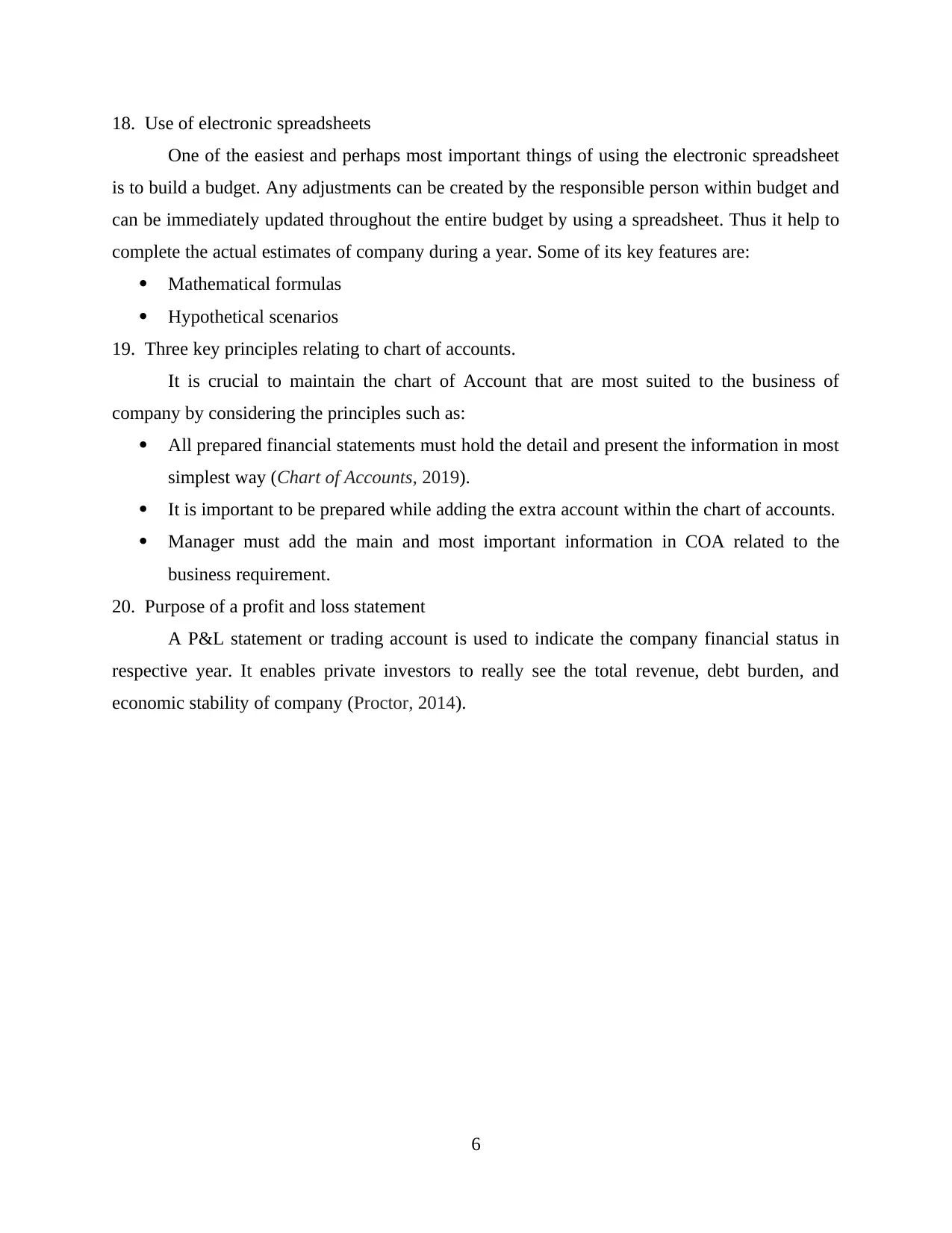
18. Use of electronic spreadsheets
One of the easiest and perhaps most important things of using the electronic spreadsheet
is to build a budget. Any adjustments can be created by the responsible person within budget and
can be immediately updated throughout the entire budget by using a spreadsheet. Thus it help to
complete the actual estimates of company during a year. Some of its key features are:
Mathematical formulas
Hypothetical scenarios
19. Three key principles relating to chart of accounts.
It is crucial to maintain the chart of Account that are most suited to the business of
company by considering the principles such as:
All prepared financial statements must hold the detail and present the information in most
simplest way (Chart of Accounts, 2019).
It is important to be prepared while adding the extra account within the chart of accounts.
Manager must add the main and most important information in COA related to the
business requirement.
20. Purpose of a profit and loss statement
A P&L statement or trading account is used to indicate the company financial status in
respective year. It enables private investors to really see the total revenue, debt burden, and
economic stability of company (Proctor, 2014).
6
One of the easiest and perhaps most important things of using the electronic spreadsheet
is to build a budget. Any adjustments can be created by the responsible person within budget and
can be immediately updated throughout the entire budget by using a spreadsheet. Thus it help to
complete the actual estimates of company during a year. Some of its key features are:
Mathematical formulas
Hypothetical scenarios
19. Three key principles relating to chart of accounts.
It is crucial to maintain the chart of Account that are most suited to the business of
company by considering the principles such as:
All prepared financial statements must hold the detail and present the information in most
simplest way (Chart of Accounts, 2019).
It is important to be prepared while adding the extra account within the chart of accounts.
Manager must add the main and most important information in COA related to the
business requirement.
20. Purpose of a profit and loss statement
A P&L statement or trading account is used to indicate the company financial status in
respective year. It enables private investors to really see the total revenue, debt burden, and
economic stability of company (Proctor, 2014).
6
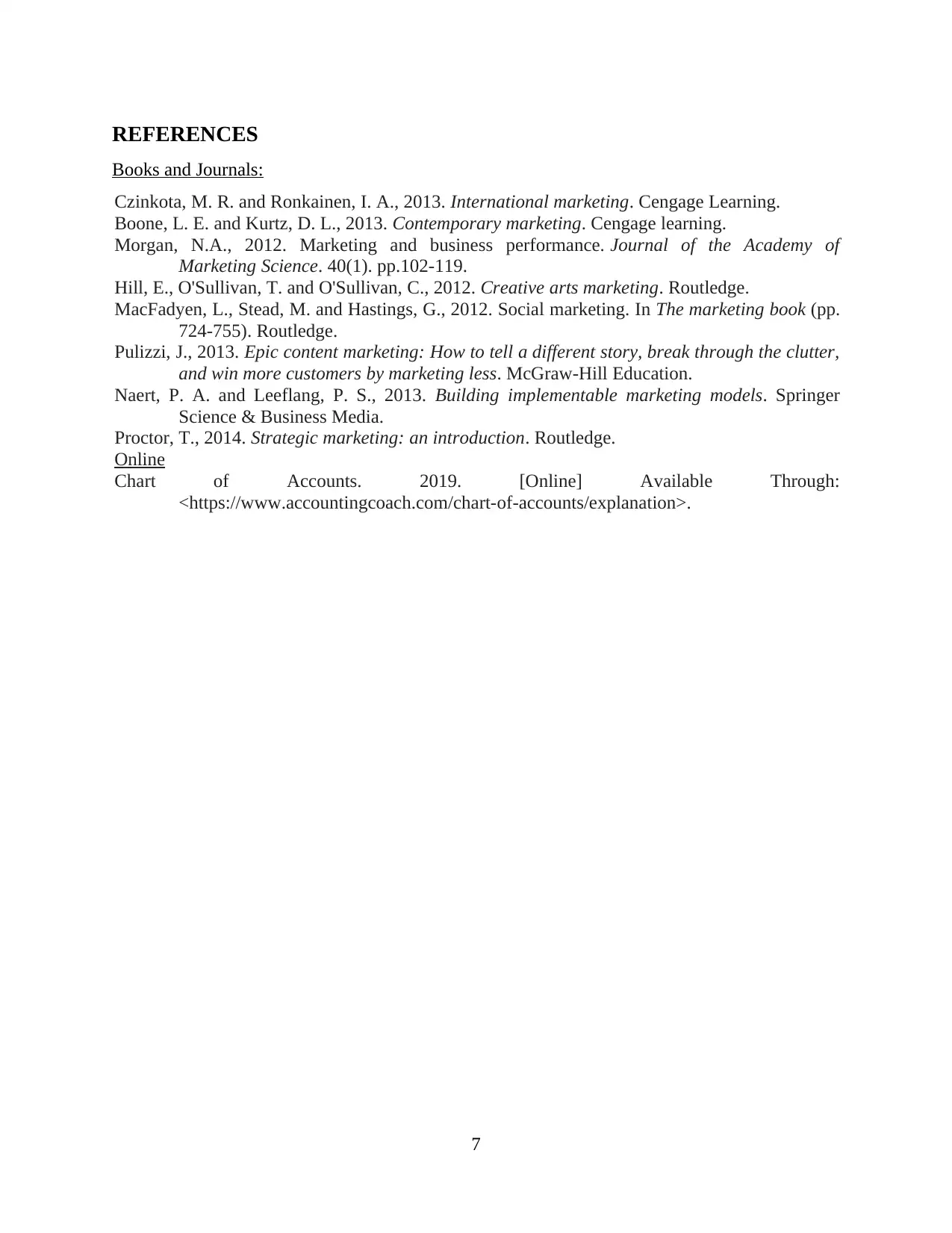
REFERENCES
Books and Journals:
Czinkota, M. R. and Ronkainen, I. A., 2013. International marketing. Cengage Learning.
Boone, L. E. and Kurtz, D. L., 2013. Contemporary marketing. Cengage learning.
Morgan, N.A., 2012. Marketing and business performance. Journal of the Academy of
Marketing Science. 40(1). pp.102-119.
Hill, E., O'Sullivan, T. and O'Sullivan, C., 2012. Creative arts marketing. Routledge.
MacFadyen, L., Stead, M. and Hastings, G., 2012. Social marketing. In The marketing book (pp.
724-755). Routledge.
Pulizzi, J., 2013. Epic content marketing: How to tell a different story, break through the clutter,
and win more customers by marketing less. McGraw-Hill Education.
Naert, P. A. and Leeflang, P. S., 2013. Building implementable marketing models. Springer
Science & Business Media.
Proctor, T., 2014. Strategic marketing: an introduction. Routledge.
Online
Chart of Accounts. 2019. [Online] Available Through:
<https://www.accountingcoach.com/chart-of-accounts/explanation>.
7
Books and Journals:
Czinkota, M. R. and Ronkainen, I. A., 2013. International marketing. Cengage Learning.
Boone, L. E. and Kurtz, D. L., 2013. Contemporary marketing. Cengage learning.
Morgan, N.A., 2012. Marketing and business performance. Journal of the Academy of
Marketing Science. 40(1). pp.102-119.
Hill, E., O'Sullivan, T. and O'Sullivan, C., 2012. Creative arts marketing. Routledge.
MacFadyen, L., Stead, M. and Hastings, G., 2012. Social marketing. In The marketing book (pp.
724-755). Routledge.
Pulizzi, J., 2013. Epic content marketing: How to tell a different story, break through the clutter,
and win more customers by marketing less. McGraw-Hill Education.
Naert, P. A. and Leeflang, P. S., 2013. Building implementable marketing models. Springer
Science & Business Media.
Proctor, T., 2014. Strategic marketing: an introduction. Routledge.
Online
Chart of Accounts. 2019. [Online] Available Through:
<https://www.accountingcoach.com/chart-of-accounts/explanation>.
7
1 out of 10
Related Documents
Your All-in-One AI-Powered Toolkit for Academic Success.
+13062052269
info@desklib.com
Available 24*7 on WhatsApp / Email
![[object Object]](/_next/static/media/star-bottom.7253800d.svg)
Unlock your academic potential
© 2024 | Zucol Services PVT LTD | All rights reserved.




